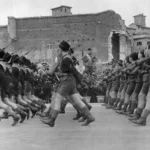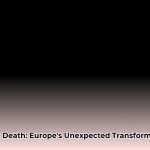Imagine Strasbourg in 1518: a city ensnared by a perplexing phenomenon. People danced uncontrollably for weeks, leading to exhaustion, injury, and even death. Was this a case of mass psychogenic illness, a toxic fungus, divine punishment, or a combination of factors? This article delves into the mystery of the 1518 Dancing Plague, exploring the various explanations, societal fears, and the authorities’ reactions to this baffling chapter of history. For another historical medical mystery, check out this fascinating case.
The Dancing Plague of 1518: A Bizarre Case
In the summer of 1518, Strasbourg, then part of the Holy Roman Empire, witnessed an extraordinary event: a woman began dancing in the street, and soon, hundreds joined her in a relentless, bizarre dance. This is the infamous Dancing Plague of 1518 – a historical enigma that continues to intrigue and perplex historians, medical experts, and social scientists alike. How susceptible are populations to outbreaks of mass psychogenic illness under conditions of severe stress?
What triggered this outbreak? Was it solely a mass delusion, a collective mental breakdown fueled by superstition and fear? Or was there a hidden environmental factor, such as a toxic substance, affecting their bodies and minds? The truth, as is often the case with historical mysteries, is likely far more complex than any single explanation can provide.
A City’s Uncontrollable Dance: More Than Just Moving Feet
The Dancing Plague started insidiously, with one woman’s seemingly uncontrollable twirling and shaking. Others joined, mirroring her frantic energy. This was no joyful dancing; it was an exhausting, involuntary dance marathon, pushing the afflicted to their physical limits and leading to injuries, profound exhaustion, and, in some cases, even death. Eyewitness accounts from the time describe the dancers as feverish, agitated, and sometimes delirious, their faces contorted in expressions of anguish and desperation. The citizens of Strasbourg watched in fear and confusion as their loved ones succumbed to this strange affliction, powerless to stop the relentless dance.
Unraveling the Mystery: Theories of Unintentional Movements
Historians and medical experts have proposed several theories to explain the Dancing Plague, with two primary explanations dominating the discourse. The first is mass psychogenic illness (MPI), a condition in which psychological stress and anxiety manifest as widespread physical symptoms within a population. This theory suggests that the Dancing Plague was a form of collective hysteria, a contagious panic attack fueled by the immense pressures and fears of the time. The second, and perhaps more controversial, theory is ergot poisoning, caused by consuming bread made from rye grain contaminated with ergot, a fungus that produces toxic alkaloids. Ergot poisoning, also known as ergotism, can lead to a range of symptoms, including hallucinations, convulsions, and uncontrolled movements.
Consider the implications of each theory: if the Dancing Plague was primarily a psychological phenomenon, it would highlight the immense power of the human mind to influence physical health and behavior. On the other hand, if ergot poisoning was the primary cause, it would underscore the vulnerability of populations to environmental toxins and the importance of food safety.
Europe in 1518 was a cauldron of hardship, marked by famine, disease, social unrest, and religious upheaval. Constant fear of starvation, illness, and divine punishment could have created an environment ripe for mass hysteria. Ergot, with its hallucinogenic and convulsant properties, may have been the trigger that set the stage for the Dancing Plague.
Which theory is the most accurate? The most plausible explanation may lie in a combination of both. The stressful conditions of 16th-century Europe may have made people more vulnerable to the effects of ergot or suggestion, magnifying a potentially milder physical ailment into a full-blown epidemic of uncontrollable dancing.
Strasbourg’s Response: From Religious Rituals to Forced Rest
Strasbourg’s initial response to the Dancing Plague was perplexing, reflecting the limited medical knowledge and prevailing superstitions of the time. Authorities seemed passive, initially allowing the dancing to continue, perhaps believing it was a temporary phenomenon that would eventually subside on its own. Many believed it to be a divine affliction, a punishment from God for the sins of the people. They tried to appease divine anger through religious processions, public prayers, and invocations to St. Vitus, the patron saint of dancers and epileptics, who was believed to have the power to both inflict and cure the dancing plague.
However, as the dancing continued unabated, causing economic disruption and an increasing number of casualties, authorities shifted their strategy. Recognizing that the religious rituals were not effective, they moved from religious appeasement to forceful attempts to stop the dancing. They resorted to physical restraints, isolating the afflicted from the general population, and even hiring musicians and building a stage, hoping that structured music and dancing would provide an outlet for the frenzied energy and somehow cure the dancers. This change in approach illustrates how societal anxieties and concerns about the economic and social disruption ultimately overrode the initial spiritual perspective, leading to more pragmatic, albeit still misguided, interventions.
The effectiveness of these interventions remains uncertain. Did they help end the Dancing Plague, or did the outbreak simply subside on its own, perhaps due to changes in environmental conditions or the exhaustion of the afflicted?
The Lasting Legacy
The Dancing Plague of 1518 serves as a haunting reminder of human vulnerability in times of crisis and how easily fear, uncertainty, and misinformation can spread through a population. The event underscores the limitations of medical understanding in the 16th century and highlights the complex interactions between physical and mental well-being. It also serves as a cautionary tale about the importance of understanding and addressing the underlying social and economic factors that can contribute to mass psychogenic illness.
The mystery surrounding its cause continues to inspire research and debate among historians, medical experts, and social scientists, underscoring the need for a more nuanced and interdisciplinary understanding of historical events. How can societies better address epidemics, both physical and psychological, in the face of uncertainty and fear? The lessons learned from the Dancing Plague of 1518 remain relevant today, as we grapple with new and emerging health crises.
Key aspects of the Dancing Plague:
- Cause: A complex interplay of mass psychogenic illness, ergot poisoning from contaminated grain, and underlying social and economic stressors. This emphasizes the importance of considering the complex interplay of psychological, environmental, and socio-economic factors in understanding historical events.
- Context: A period of widespread famine, disease, social unrest, and religious upheaval in 16th-century Europe. Highlights the importance of understanding the socio-environmental context in shaping vulnerability to illness and mass psychogenic phenomena.
- Response: A shift from initial religious attempts to more forceful interventions, reflecting changing societal understanding and responses to mysterious outbreaks. It illustrates the evolving nature of societal responses to health crises in the face of uncertainty and fear.
- Legacy: A chilling reminder of human vulnerability and the ongoing quest to understand historical mysteries. Underscores the importance of examining social, medical, and psychological factors in understanding collective behavior.
The Dancing Plague continues to fascinate and disturb, a chilling reminder that certain aspects of human behavior, particularly in times of crisis, remain shrouded in mystery. The social and economic conditions of 16th-century Europe, with its widespread famine, disease, and social unrest, undoubtedly played a significant role in shaping the events of 1518. How can we learn from this historical enigma to better understand and address the challenges of today?
How did environmental factors influence the 1518 Strasbourg Dancing Plague?
Key Takeaways:
- The 1518 Strasbourg Dancing Plague remains an enigma, defying easy explanation.
- Environmental conditions, coupled with psychological and socio-economic factors, likely played a significant role in the outbreak.
- The lack of detailed and reliable historical records makes definitive conclusions challenging.
- Further interdisciplinary research is needed to fully understand the complex factors that contributed to this historical event.
The Unfolding Mystery
July 1518. Strasbourg. A woman starts dancing uncontrollably in the street. Soon, others join her, their movements becoming increasingly frantic and relentless. Hundreds, then thousands, are swept up in the bizarre phenomenon. What caused the Dancing Plague? Was it a case of mass hysteria, a mysterious toxin in the water supply, or something else entirely? How did environmental factors influence this extraordinary outbreak?
The Role of the Environment and Societal Stress
One prominent theory points to ergot poisoning, a fungal infection of rye grain with toxins causing hallucinations, convulsions, and gangrene. However, the extended duration of the dancing and the absence of other typical ergotism symptoms raise doubts about this being the sole explanation.
Beyond ergot, Strasbourg faced numerous environmental and socio-economic hardships in 1518. Famine gripped the region, leading to soaring grain prices and widespread hunger. Rampant outbreaks of smallpox and syphilis further devastated the population, weakening their physical and mental resilience. These stressors would have significantly impacted the population’s physical and mental health, creating fertile ground for mass psychogenic illness. Could the widespread misery and desperation have exacerbated susceptibility to a contagious form of mass hysteria?
Strasbourg’s location along the Rhine and Moselle rivers played a critical role in its economy as a major trade hub. Did environmental conditions along these waterways, such as contaminated water sources or increased exposure to disease vectors, contribute to the spread of any potential contagion? Or did the dense population in these urban centers simply increase the likelihood of contagious behavior, whether physical or psychological? These are critical questions that need further exploration. How much of the population was directly impacted by these adverse environmental conditions?
Socio-Cultural Context
The prevailing religious beliefs of the time are also of paramount importance in understanding the Dancing Plague. The year 1518 was one of profound anxiety and uncertainty, marked by widespread fear of divine punishment and the looming threat of the apocalypse. The dancing could have been interpreted as a form of religious fervor or, conversely, as a sign of divine displeasure. The authorities’ attempts to “cure” the dancers by providing music and creating designated dancing areas may have inadvertently amplified the phenomenon, illustrating the complex interplay between societal beliefs, cultural practices, and the spread of the affliction.
The dance itself was far from a joyful jig. Contemporary accounts describe exhausting, relentless movement, pushing the dancers to their physical limits and leading to exhaustion, injury, and even death. What started as a singular event quickly snowballed into a collective phenomenon, indicating a strong psychological component.
Unanswered Questions and Future Research
Despite centuries of debate and scholarly inquiry, the true cause of the Dancing Plague remains unresolved. The absence of reliable mortality records and detailed medical accounts further clouds our understanding of this historical event. While ergot poisoning and mass psychogenic illness are the most widely discussed theories, the complex interplay of environmental stressors, social anxieties, prevailing religious beliefs, and a contagious psychological element must be considered. Future research should integrate medical, psychological, sociological, and environmental perspectives to gain a more comprehensive understanding of this historical enigma. What specific social factors contributed to the outbreak and spread of the Dancing Plague?
Community Impact- The Dancing Plague of 1518 and Societal Response
Key Takeaways:
- Hundreds of people in Strasbourg danced uncontrollably for days, weeks, and even months in 1518, causing widespread panic and disruption.
- A significant number of deaths resulted from exhaustion, heart attacks, strokes, and other health issues exacerbated by the relentless dancing. What was the estimated death toll?
- The precise cause of the Dancing Plague remains a subject of intense debate, with theories ranging from mass psychogenic illness to ergot poisoning.
- The event reflects the pervasive anxieties of the time, including religious upheaval, famine, and disease.
- The authorities’ initial reaction of seemingly encouraging the dancing may have inadvertently prolonged the crisis.
- The Community Impact- The Dancing Plague of 1518 and Societal Response was profound and far-reaching, leaving a lasting mark on the collective memory of Strasbourg.
A City’s Unraveling
July 1518. Strasbourg. A woman began to dance in the street, her movements frantic and uncontrolled. Then another joined her, and another. Soon, hundreds of people were swept up in a bizarre, uncontrollable frenzy, their bodies moving relentlessly to an unseen rhythm. They danced day and night, some for weeks, others for months, their faces contorted in expressions of anguish and desperation. Was it a curse? A punishment from God? Or something far more perplexing and unsettling?
Symptoms and Scale
The dancers weren’t merely swaying to music; their movements were frenetic, exhausting, and often self-destructive. Many collapsed from sheer exhaustion, dehydration, and even heart attacks and strokes brought on by the relentless physical exertion. Some died, their bodies unable to withstand the prolonged ordeal. The sheer scale of the outbreak was astonishing – hundreds of people afflicted, spanning all social classes and demographics. This wasn’t a localized incident confined to a small group; it gripped the entire community of Strasbourg, leaving its residents in a state of fear and confusion.
Theories
Historians and scientists have proposed various explanations for the Dancing Plague. One prominent theory points to ergot poisoning, a fungal infection of rye grain that can trigger hallucinations and convulsions, potentially mimicking the dancers’ symptoms. However, conclusive evidence linking ergot to every participant remains elusive.
Another explanation focuses on mass psychogenic illness (MPI), a phenomenon where large groups of people develop similar physical symptoms with no identifiable organic cause, often arising during times of high stress and anxiety. The 16th-century Europe was undergoing immense social and religious upheaval, with the Protestant Reformation challenging the established order. Luther’s 95 Theses had shaken the religious foundations of the continent, leading to widespread uncertainty and fear. Famine and disease were rampant, further exacerbating the collective anxiety. In this context, a collective psychological response, manifesting as uncontrollable dancing, seems plausible.
The City’s Response
Strasbourg’s authorities, initially reacted in ways that might seem baffling to modern observers. Instead of trying to suppress the dancing, they seemingly encouraged it, setting up stages, hiring musicians, and even providing food and shelter for the dancers. Their reasoning, perhaps, was that allowing the frenzy to run its course would be less harmful than forceful intervention, which could potentially incite further unrest. However, this decision, in hindsight, may have inadvertently prolonged the crisis, as the music and public spectacle may have inadvertently fueled the contagion of the dancing. We can see how their response, based on the limited medical understanding of the time, tragically lengthened the period of suffering and disruption.
Legacy
The Dancing Plague of 1518 remains a chilling and fascinating enigma in the annals of history. It underscores the power of social contagion and the fragility of the human mind under pressure. It serves as a cautionary tale, showing how easily unfounded beliefs and anxieties can spread through a population, leading to unexpected and potentially harmful consequences. But it also throws light on Community Impact- The Dancing Plague of 1518 and Societal Response: the profound effect a collective psychological event can have on a community and its leaders, shaping its social fabric and leaving a lasting legacy. It highlights the need for an evidence-based and compassionate approach when dealing with mass psychological phenomena, emphasizing the importance of understanding the underlying causes and addressing the needs of the afflicted with empathy and care. How can societies better prepare for and respond to similar events in the future?
Expert Insights- Historical Accounts of the 1518 Dancing Plague
Europe, The 1518 Summer
Imagine Strasbourg, 1518. A woman starts dancing in the street. Not a joyful jig, but a frantic, uncontrolled frenzy. Soon, others join, their movements mirroring her anguish and desperation. Dozens, then hundreds, are swept up in this bizarre phenomenon. This wasn’t a joyful celebration; it was a terrifying, unsettling outbreak – the Dancing Plague. What caused this bizarre episode? Expert Insights- Historical Accounts of the 1518 Dancing Plague reveal a captivating mystery, defying easy explanation and challenging our understanding of human behavior.
Theories
Two main explanations vie for prominence among historians and medical experts: ergot poisoning and mass psychogenic illness (MPI). Ergot is a fungus that can contaminate rye grain, producing toxic alkaloids that, when ingested, can cause hallucinations, convulsions, and—yes—involuntary movements. Was this the primary culprit behind the Dancing Plague? However, evidence directly linking ergot to every participant in the outbreak remains frustratingly elusive.
Then there’s MPI, a condition where symptoms spread rapidly through a population due to psychological factors, often triggered by stress, anxiety, and social contagion. Could the turbulent social and political climate of 16th-century Europe, marked by religious conflict, economic hardship, and the ever-present threat of disease, have fueled a collective anxiety that manifested as uncontrollable dancing? The time period was rife with social upheaval, religious unrest, and economic instability, creating ideal conditions for such an event to take hold.
Was it ergot? Was it mass hysteria? Or, perhaps, a chilling combination of both, with ergot poisoning acting as a trigger for a mass psychogenic event? The lack of definitive proof allows both arguments to persist, adding to the enduring intrigue of the mystery.
Beyond Strasbourg
The Dancing Plague wasn’t isolated to Strasbourg. Similar events, though often less well-documented and on a smaller scale, occurred throughout Europe during the medieval and early modern periods. This suggests the existence of underlying factors, something beyond a singular, local incident. Could a recurring environmental factor, such as the widespread consumption of contaminated grain, have contributed to these events across both time and place? Or were there common social and psychological stressors that made populations across Europe vulnerable to mass psychogenic illness?
The Human Element
The historical accounts of the Dancing Plague emphasize the physical and emotional suffering of the afflicted. The dancers endured exhaustion, injury, and even death as a result of their relentless movements. People danced until they collapsed from exhaustion, their bodies battered and bruised, sometimes sustaining severe injuries. Some died from heart attacks, strokes, and other complications brought on by the prolonged ordeal. The descriptions emphasize the involuntary nature of their movements, highlighting the anguish and suffering involved.
Authorities’ response to the Dancing Plague is telling, reflecting the fear and uncertainty that gripped the city. Instead of attempting to suppress the dancing through force, they tried to manage it, creating designated dancing areas and even providing music, perhaps hoping to channel the frenzied energy and prevent further chaos. This highlights the societal impact of the event and provides insight into the limitations of 16th-century medical understanding. Religious beliefs might have deepened the sense of fatalism. Why and how did the religious beliefs deepen the sense of fatalism and influence the response to the Dancing Plague?
Lessons Learned
The Dancing Plague serves as a stark illustration of the fragility of human health, both physical and mental, and the interconnectedness of individual well-being and societal stability. Its haunting tale reminds us of the power of psychological factors and the importance of understanding the complex interplay between social, environmental, and psychological forces in shaping human behavior. It’s a reminder that historical phenomena, even those that seem bizarre and inexplicable, hold valuable insights into the human condition.
Key Takeaways:
- The Dancing Plague of 1518 remains a captivating historical mystery.
- Ergot poisoning and mass psychogenic illness are the leading explanations for the event.
- The Dancing Plague highlights the complex interplay of physical and psychological factors in shaping human behavior.
- The societal response to the Dancing Plague reflects the widespread fear and uncertainty of the time.
- The Dancing Plague offers valuable insights into the limitations of 16th-century understanding and the importance of interdisciplinary approaches to understanding historical phenomena.
















